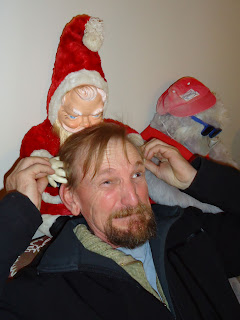Okay, true confession time. I've always wanted a Silk Garden sweater, so I told Jim that was what I wanted for Christmas this year. I've been going to knit and chat on Friday nights at Cotton By Post (first time I've ever felt like I truly had a LYS) and Suzanne carries Noro, so that's where I bought it from. She even wrapped up my purchase so I could open it Christmas morning. (Thanks Suzanne for the extra love.)
Once I had a quiet moment on Christmas day, I swatched it up using a 4.5mm needle and also with a 4mm needle. I washed it, left it to dry and later measured the gauge to be 4.5 stitches to the inch on 4.5mm needles and 5 stitches to the inch on 4mm needles. I liked the firmer gauge on the smaller needle. Silk Garden has oodles of drape, and the looser gauge feels floppy to me. My stitches also seemed neater on the smaller needle.
I chose color 84 - reds, which is understandably very popular.
I had planned to make the Banstead Pullover, but it calls for 4 stitches to the inch, so that pattern was right out for this yarn. I really love the Knitting Plus book, so I pored over it, hoping to match my yarn to a pattern. I considered the Passayunk Pullover, it looked like the gauge would match, but then these words in the pattern description brought me up short:
"The Yoke is fairly shallow... If you know this shallow yoke will not work for you because you are tall or have broad shoulders..."
Oh me! I am tall, I do have broad shoulders. Then I remembered that Lisa Shroyer covers this topic at the beginning of her book:
"...I found that drop-shoulder sweaters fit some women - those with broad, high shoulders - beautifully. The sweaters weren't oversized or disproportionate. In fact, they fit these women much better than the set-in sweaters (my assumed best-fit style for all plus-sized women). Women, and especially tall women, with broad shoulders and a large frame benefit greatly from the wider shoulder and wider cross-back of the drop-shoulder construction."For me, this is a lightening bolt of truth. The sweater I wear the most is a drop-shoulder design, but I use it for walking the dog because it always seemed wrong. Yes, the sweater was comfortable and fit well, but everything we read these days talks about "fit to flatter", with words like "body skimming" and all sorts of shaping techniques like darts and short rows. Making an old eighties-style boxy design seems so out-dated.
I've worked the yoke sweaters. One creeps up my neck and chokes me, the other is the opposite extreme with a neck far to wide to be warm and an awkward fit. I know raglans are absolutely no good, I look like a ball player.
But now I understand, I have a large boned, tall frame and I'm not the only one. So I'm going to embrace my shape and knit what works for me. This yarn is beautiful and I deserve to have it knit into a sweater that I will want to wear all the time.
I'm using Paton's Back to Basics pattern book for Canadiana, which fit my preferred gauge. I'm leaning towards doing a v-neck, but I haven't ruled out a round neck either. I'm also working this flat because Lisa suggested it for another singles yarn in her book, in order to counteract the tendency of a single to bias. She's smart, that Lisa Shroyer, isn't she?
Oh! And you know what that cutie-patootie husband of mine did? He utterly spoilt me, that's what. Look at this lovely new project bag he gave me for Christmas, also from Cotton-By-Post, art by Laurel Burch:
It was a very good Christmas.








